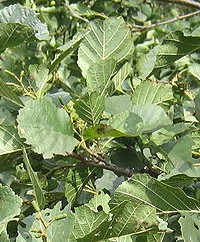 This deciduous tree, native to Europe and western Asia, was introduced to North America in colonial times. It is usually a narrow, multi-stemmed tree with oval to round simple leaves that are dark green on the upper side and lighter green beneath. The leaves may be green or brown when they fall off the tree late in the season. Long male catkins and short female catkins are produced on the same tree; the female catkins become somewhat woody in fall and superficially resemble cones. European alder quickly grows to fifty feet or more and is short lived. The greatest virtue of the tree is its ability to fix atmospheric nitrogen in the soil making it a good tree for poor soils. Fallen live branches can root in wet soil and the tree can become invasive. Since European alder especially likes moist soil they may threatens wetland species. A few attractive cultivars are available but unless the tree is needed for a specific difficult site, better trees are available and should be used. European alder is in the birch family, Betulaceae, that also includes hornbeans and hazels. The genus name, Alnus, is the classical Latin name for one of the genera. The specific epithet, glutinosa, the Latin word meaning sticky.
This deciduous tree, native to Europe and western Asia, was introduced to North America in colonial times. It is usually a narrow, multi-stemmed tree with oval to round simple leaves that are dark green on the upper side and lighter green beneath. The leaves may be green or brown when they fall off the tree late in the season. Long male catkins and short female catkins are produced on the same tree; the female catkins become somewhat woody in fall and superficially resemble cones. European alder quickly grows to fifty feet or more and is short lived. The greatest virtue of the tree is its ability to fix atmospheric nitrogen in the soil making it a good tree for poor soils. Fallen live branches can root in wet soil and the tree can become invasive. Since European alder especially likes moist soil they may threatens wetland species. A few attractive cultivars are available but unless the tree is needed for a specific difficult site, better trees are available and should be used. European alder is in the birch family, Betulaceae, that also includes hornbeans and hazels. The genus name, Alnus, is the classical Latin name for one of the genera. The specific epithet, glutinosa, the Latin word meaning sticky.
Type: Deciduous tree
Outstanding Features: Nitrogen fixing; invasive
Form: Often multi-stemmed, narrow
Growth Rate: Rapid

Bloom: Long reddish male and short female catkins produced on the same tree; female catkins become woody in fall.
Size: 40-60’ H x 24-40’ W
Light: Full sun
Soil: Poor, moist
Hardiness: Zones 3-7
Pests and Diseases: Susceptible to powdery mildew, alder aphids, lacebug, flea beetle, leaf miner
Propagation: Seed and cuttings
Outstanding Selection: ‘Imperialis’ (dissected leaves).
